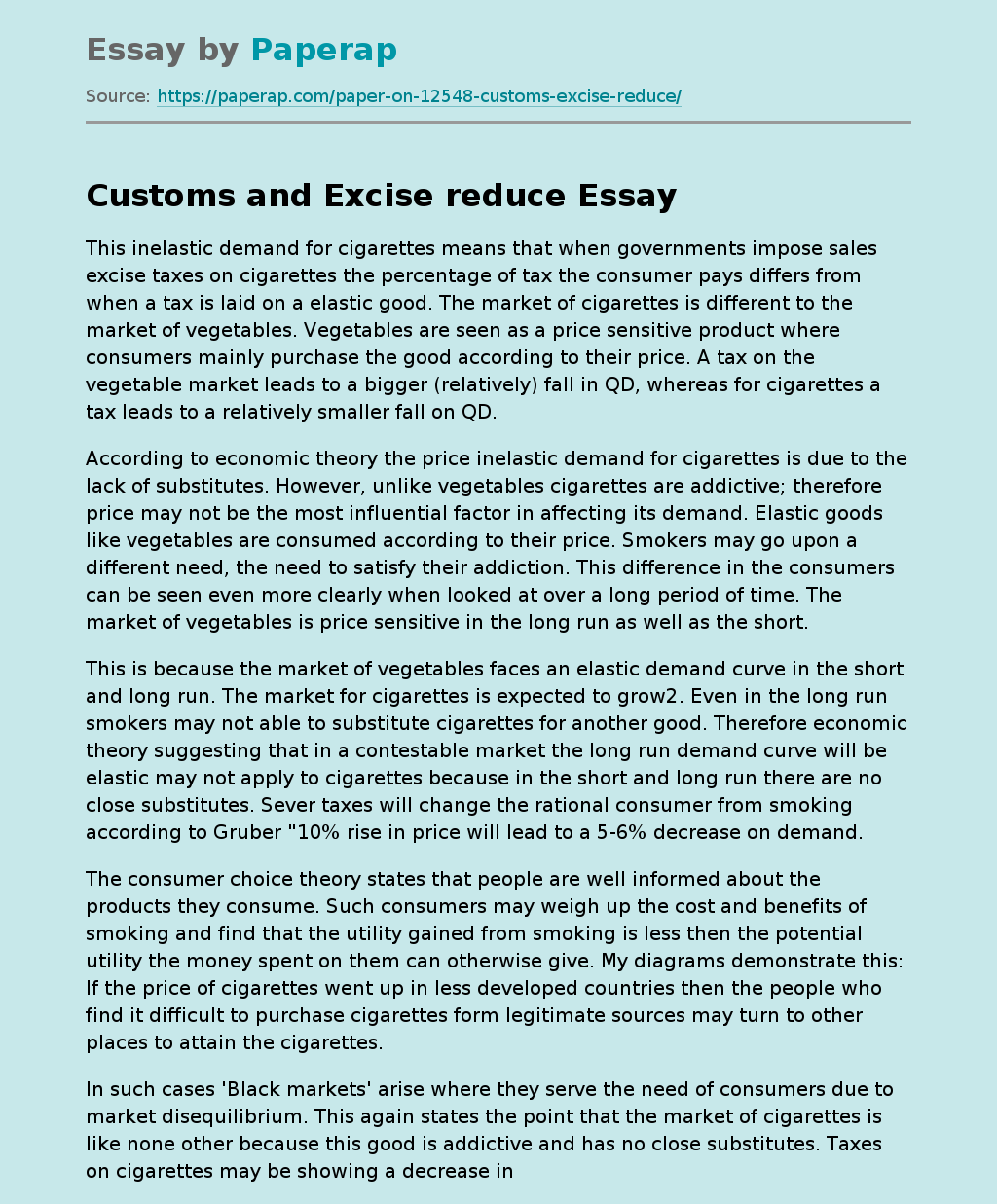Cigarette Market vs Vegetable Market
The following example essay on “Cigarette market vs vegetable market” talks about how the cigarette market differs from the vegetable market. The essay analyzes customs and excise duty
This inelastic demand for cigarettes means that when governments impose sales excise taxes on cigarettes the percentage of tax the consumer pays differs from when a tax is laid on a elastic good. The market of cigarettes is different to the market of vegetables. Vegetables are seen as a price sensitive product where consumers mainly purchase the good according to their price.
A tax on the vegetable market leads to a bigger (relatively) fall in QD, whereas for cigarettes a tax leads to a relatively smaller fall on QD.
According to economic theory the price inelastic demand for cigarettes is due to the lack of substitutes. However, unlike vegetables cigarettes are addictive; therefore price may not be the most influential factor in affecting its demand. Elastic goods like vegetables are consumed according to their price. Smokers may go upon a different need, the need to satisfy their addiction. This difference in the consumers can be seen even more clearly when looked at over a long period of time. The market of vegetables is price sensitive in the long run as well as the short.
This is because the market of vegetables faces an elastic demand curve in the short and long run. The market for cigarettes is expected to grow2. Even in the long run smokers may not able to substitute cigarettes for another good.
Therefore economic theory suggesting that in a contestable market the long run demand curve will be elastic may not apply to cigarettes because in the short and long run there are no close substitutes. Sever taxes will change the rational consumer from smoking according to Gruber “10% rise in price will lead to a 5-6% decrease on demand.
The consumer choice theory states that people are well informed about the products they consume. Such consumers may weigh up the cost and benefits of smoking and find that the utility gained from smoking is less then the potential utility the money spent on them can otherwise give. My diagrams demonstrate this: If the price of cigarettes went up in less developed countries then the people who find it difficult to purchase cigarettes form legitimate sources may turn to other places to attain the cigarettes.
In such cases ‘Black markets’ arise where they serve the need of consumers due to market disequilibrium. This again states the point that the market of cigarettes is like none other because this good is addictive and has no close substitutes. Taxes on cigarettes may be showing a decrease in consumption, hence justifying tax increases. However, the people in between e – e1, as my graph demonstrates may actually turn to the black market to get the same good but a lower price. In conclusion I have demonstrated that cigarettes can not be classified as an inferior good.
However cigarettes may not even be classified as an elastic or inelastic good as for these conditions are to be met there has to be close substitutes in the short and long run. Therefore when describing the effects of a tax on the market of cigarettes traditional microeconomic theory may not be used but instead one may take aspects of macroeconomic theory to describe the effects of a tax on the aggregate market of cigarettes.
“Some analysts still expect the tobacco industry to show earnings growth of 11. 5% over the next five years” BBC. CO. UK Tobacco trend for high income countries 2002 796 QC Consumer choice theory assumes that consumers are well informed about the products that they buy and that the ‘economic man’ acts rationally in maximising his utility. However, as evidence by Gruber shows that “Smoking is done primarily by the youth, whose ability to make fully informed decisions are questioned by society”. Gruber describes that consumers are not well aware of the facts of smoking. Young smokers may not be acting rationally because cigarettes are addictive.
It may be that consumers are rational and well informed but when it comes to addictive goods such as cigarettes their addiction over powers their sense of judgement. In the UK there is a law prohibiting anyone under the age of 16 to purchase cigarettes from shops. The government has restricted a group of people who may have otherwise brought cigarettes. In China the government has recently banned cigarette companies from advertising. This was revealed in the Muslim weekly newspaper, again evidence demonstrating that consumers may not be well informed.
The government in the UK Intervene in the market of cigarettes as it is classified as a demerit good. This good is over consumed in a free market containing negative externalities that derive from the consumption. Other ways the government intervene are by stopping illegal imports coming into the country. The government has imposed quotas on consumers restricting the amount they can bring into the country. These actions go against the free market ideology; however, politically it is seen correct by the majority of the population. Customs and Excise reduce the supply of cigarettes that circulate the black market.
This will then create a bigger effect in decreasing the demand for cigarettes when the price is raised through taxes. My diagram shows that when the price is raised demand according to theory is supposed to go down, however due to the size of the black market economic theory may not be taking place but with a reduction in supply in the black market aggregate QD will go down. Governments also intervene in the market by not allowing cigarette companies to advertise. But advertisers have penetrated the market in other ways. One of the ways it has done this is by using the cigarette logo’s and symbols instead of the company names.
Cigarette Market vs Vegetable Market. (2018, Jan 13). Retrieved from https://paperap.com/paper-on-12548-customs-excise-reduce/

